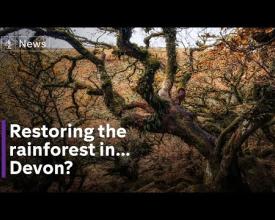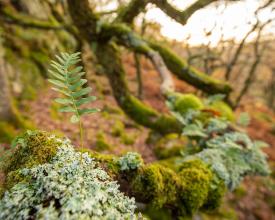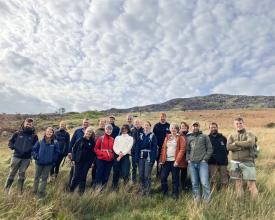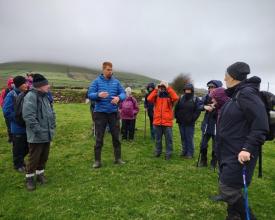
Temperate Rainforest Restoration Programme on the West Coast of the UK and on the Isle of Man
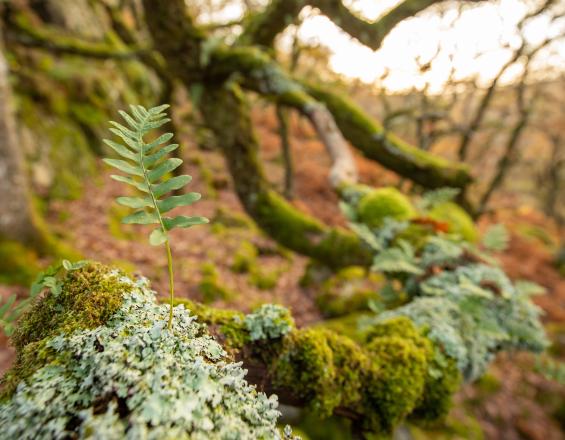
Temperate rainforest is often affectionately described as woodland where there is ‘green on green on green’, due to the hundreds of species of plants and lichens which cover every surface. The west coast of the British Isles, with its high rainfall and infrequency of winter snow, steady temperatures, and clean air, is one of the few places globally with the right conditions for it to form and thrive.
Once covering a fifth of our land, there are now only a few scattered fragments remaining- with the majority in Scotland (approximately 30,000 hectares). There are fragments still in parts of Devon, Cornwall, Wales, Lancashire, Cumbria, Yorkshire, Northern Ireland, and the Isle of Man – an area collectively termed our ‘oceanic zone’. Conserving and expanding our temperate rainforest is of vital importance not only for carbon sequestration, but also to protect ancient plant life, and to keep migrating populations of pied flycatchers, wood warblers, redstarts, and tree pipits coming back to our woodlands each year.
Context
Challenges addressed
Temperate (otherwise known as Atlantic or Celtic) rainforest is one of the most globally rare habitats, rarer than even tropical rainforest. The ancient woodlands now cover less than 1% of the UK and the Isle of Man, when they used to cover 20%.
Location
Process
Summary of the process
.
Building Blocks
Carbon accounting
This programme uses the Woodland Carbon Code (WCC) to validate the carbon credits generated. The WCC is a voluntary code which encourages consistency within woodland creation and carbon projects, while offering transparency to customers too. The process of validation and verification means any woodlands included in the scheme are certified to be sustainably managed according to national standards. This provides reliable, calculated estimates of the amount of carbon that will be sequestered as a direct result of planting new trees. This concept of additionality is vital. To gain carbon credits, it must be clear that all sequestered carbon is a result of new efforts, which would not have come about without the project. Projects involved must also have a long-term management plan and maintain verification for their whole duration. As part of our partnership, all carbon credits established by the planting of temperate rainforest are allocated to Aviva, helping to deliver their net zero ambitions. The credits are only passed to Aviva once they are realised as Woodland Carbon Units. Aviva then immediately retires the units preventing any possibility of secondary trading. By not using Pending Issuance Units (PIUs), this programme ensures the highest standards of transparency and legitimacy. This is important as the restoration of temperate rainforest is a new idea and predictions of carbon returns may differ substantially from the actual units created. Nevertheless, modelling through the WCC contains large risk buffers so we expect actual returns to exceed those predicted. This programme is aligned to the ‘Nature Markets Principles’ guidelines, produced in 2023 by environmental NGOs and investors, to assist with policy development and the creation of high-quality natural capital markets. This is the first use of this code in the creation of temperate rainforest, so we are working closely with the people behind the code to better understand the carbon value of these forests.
Research
A research programme over the first eight years of the scheme has been developed to further complement this work. This will create a unique opportunity to enhance our understanding of the establishment, management, and enhancement of Atlantic rainforest habitat across the British Isles as well as updating carbon models. We will share this information with organisations seeking to bring back our native rainforests and support green investment. We are keen to explore what works where and why. Research projects will include both environmental and social components as both are critical to long-term success. Broad themes will include climate and microclimate, landscape and ecology, hydrological processes, soils, and social dimensions. There will be opportunities for research institutions and practitioners to bid into this research programme.
Baseline monitoring
Monitoring forms a significant part of ongoing work at each new site. Trusts are collecting several sources of baseline biodiversity data before planting begins. Surveys look at all sorts of wildlife, from breeding birds to bryophytes (mosses, liverworts, hornworts), and lichens to butterflies and bats. Aerial mapping will be carried out by drones. Accurate baseline data and subsequent monitoring will help show how exactly biodiversity, soil and water quality, and tree cover changes as sites transform into young temperate rainforests.
Nature reserve creation
This programme aims to go beyond traditional habitat restoration and will work to establish entirely new woodlands across eligible sites totalling at least 1,755 hectares. Aviva’s £38m donation is allowing local Wildlife Trusts to purchase, or long-term lease available land, and then establish rainforest and manage that land in perpetuity. Local Wildlife Trusts are leading on their own sites and projects, with direct support from the programme team operating from the central charity, the Royal Society of Wildlife Trusts, and input from their communities. New sites will be seen as a win for conservation and as important hubs for collaboration with local communities including educational opportunities. Local Wildlife Trusts will actively involve communities through planting days, volunteering opportunities, drop-in sessions, and guided walks.
Impacts
Our programme’s financing method is the first of its kind, and we hope it will become a model for many more partnerships between charities and businesses. Aviva and the Wildlife Trusts have entered into a 100-year long-term partnership to establish 1,755 hectares of temperate rainforest. It is a programme of national significance but informed by and completely embedded in the local context of each site. Local Wildlife Trusts, not the national charity or Aviva, own and manage their new rainforest reserves, ensuring each is created with features that local communities want and need. Our programme considers habitat creation first, and carbon second- this way the woodlands will be resilient for the future and include as many additional ecosystem benefits as possible.
Seeds are sourced locally to each site; some from existing forests, others from new nurseries which are being set up specifically for use at Wildlife Trust sites. Not only do these create jobs, but it means we can ensure each new rainforest includes locally relevant native tree species which are best suited for growth in each area and develop complex relationships with fungi in the soil.
Whilst rainforest creation is the goal, the sites being acquired always have other features and areas which are unsuitable for tree planting. This programme is therefore allowing the protection and restoration of a whole host of other habitats.
Beneficiaries
Local communities living in and around new rainforest sites will have volunteering and work opportunities. Rainforests will become places for education and for visitors, hopefully improving general health and wellbeing by encouraging people to get outdoors.
Sustainable Development Goals
Story
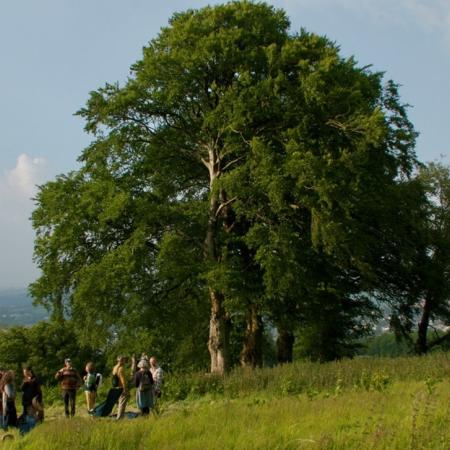
New rainforests will be managed by individual Wildlife Trusts, on behalf of their local communities. The aim is to create nature reserves where biodiverse rainforest can thrive, while also serving the needs of the people who live around them. One such example, and one of our first sites in the programme, is Bowden Pillars in Devon:
“Bowden Pillars Future Ltd is the community benefit society that was set up to buy Bowden Pillars farm on the edge of Totnes. Devon Wildlife Trust are a founding partner, and have leased 75 acres of the land for their inspiring Temperate Rainforest Project.
The farm came into our stewardship on 31 May 2023, and we marked the anniversary by inviting our supporters to join us, and spent time swapping ideas about how the project might develop. We finished with a ceremony under three ancient beech trees with the tors of Dartmoor in the distance. As well as expressing our gratitude for all the help we’ve received so far, it was a chance to feel our feet on the ground and remember our place in the wider web of life and our responsibilities towards it.
Our wider aim is to live the question ““How can we create a neighbourhood in relationship with the Land, where nature, community and farming grow together?” We’re working on plans for a new eco-village and 30 acres of regenerative farming that will grow in harmony with the new nature reserve. We’ll be offering many benefits to the local community – low-carbon affordable living, new livelihoods, opportunities for everyone to be on the land, organic local food – and have spent much of the first year finding out how best we can do this.
The farm includes an old quarry located right on the edge of the town and by the old bridleway that climbs through the DWT reserve and towards the farm. We’re consulting with the neighbours about how they would want to use the space – for small gatherings, for sessions with schools, for natural crafts, for bat-spotting and listening out for birdsong, for just sitting – and are collating the responses from an open day to help us chose our next steps.”
- Ian Hague, Project Coordinator, Bowden Pillars Future
